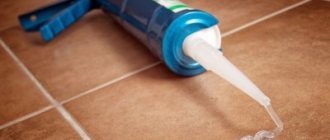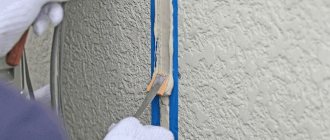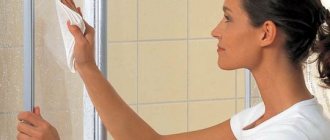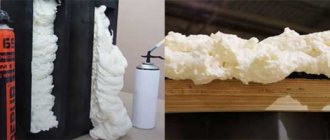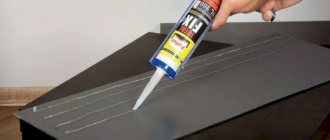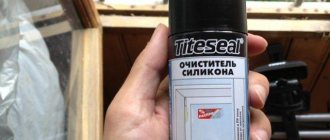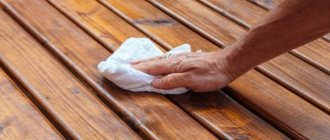Silicone is a very common material that is used in the bathroom, swimming pool, refrigerator, oven and other places, but after repair work or long-term service, its surface darkens, collapses, partially peels off from the surface, fungus and mold begin to form, the seam becomes unsealed and leaks. water, and then the question arises - how to remove silicone sealant?
Silicone glue is used in their work by builders, aquarists, motorists and many others, since this product is almost universal.
Chemical method
Another method involves cleaning the tiles from hardened silicone sealant using a chemical method.
Solvents such as acetone or white spirit are used for this. This approach allows you to deal with dried material without much effort. Wet a cotton swab or ear stick with the solution. Gently apply acetone to the areas where the sealant needs to be removed. After some time, the silicone will soften, turn into pulp and can be easily and effortlessly scraped off or wiped off with a rag.
White spirit will easily remove silicone sealant
However, before you try to wipe off the silicone sealant from the tiles with a solvent, keep in mind that if you go beyond the seam, you can ruin the tile itself, the countertop, the bathtub, and the baseboard. The liquid can damage plastic and rubber surfaces and eat away enamel and paint. Objects in contact with it may become blistered, crumble, or acquire a matte coating, and you risk breaking the seal of the seam if you go beyond the joint and remove the excess.
Before choosing one or another method of cleaning silicone sealant from tiles, weigh all the pros and cons taking into account your specific situation. But it is better, of course, to prevent contamination even at the stage of applying the sealant. Cover the tiles with masking tape and you will get a perfectly even seam with a spotlessly clean cladding surface.
This is interesting: Silicone black sealant - black adhesive-sealant, waterproof composition, packaged in 85 and 315 ml, high-temperature option for seams, Abro and Sikasil SG-20
Suitable means
Silicone does not only need to be removed during application.
It is removed if:
- when the old sealant has already become unusable and has lost its complete sealing;
- during work it turned out that due to violation of the rules, complete sealing did not occur;
- mold and mildew have appeared;
- if the surface was accidentally smeared.
The sealant penetrates very deeply into the material, which makes it very difficult to remove it from the surface, especially when it has already been in contact with it for a long period.
There are different ways to remove silicone. For some surfaces it is better to choose a mechanical method. This method should not be used to clean glass surfaces, tiles, acrylic or enamel bathtubs, otherwise they can easily be damaged. The mechanical method is suitable for cleaning surfaces that are not visible, since there is a possibility of damaging the surface during cleaning and scratches may remain.
In order to remove the old layer of sealant, you should take a knife and use it to pick up the seam. After the top layer of silicone is cut off, use the sharp end of a knife to remove any remaining silicone and clean the surface to be treated. You can use sandpaper or pumice for cleaning.
The surface should be cleaned carefully so as not to scratch or damage it.
Silicone is removed using special means. You can purchase sealant in the form of a paste, cream, aerosol or solution. Let's look at some of them.
Lugato Silicon Entferner is a special paste that can be used to easily remove dirt from many types of surfaces. The paste cleans well sealants on glass, plastic, tiles, and removes dirt from acrylic surfaces and enamel. Suitable for metal surfaces, concrete, stone, plaster, removes glue from wooden surfaces well.
Sili-kill removes dirt from brick surfaces and concrete, ceramics, metal, glass. When using, cut off the top layer of sealant, and apply this product to the surface for half an hour. Afterwards you should wash it with soapy water.
Penta-840 is a remover for cleaning sealant from surfaces made of metal, concrete, glass, and stone. This product can be used to treat cast iron bathtubs and tiles. This product is tested on a small area. To do this, apply it to a part of the surface for a few minutes and inspect whether everything is in order. After checking, remover should be applied to the sealant. After half an hour, the silicone swells and is removed with a sponge.
Dow Corning OS-2 is used to clean silicone from glass, metal, plastic, and ceramics. The top layer of sealant is removed. This product is applied for 10 minutes. Using a damp cloth or sponge, remove the residue.
You can clean silicone from the product and any surface using chemical means. Such products help get rid of silicone quickly and easily. You can use white spirit for such purposes. It helps remove adhesive from tiles, ceramics, cast iron, and glass.
White spirit should not be used on painted surfaces. When using this product, apply it to cotton wool or gauze and clean the contaminated area. After a few minutes, when the silicone becomes soft, it is removed with the tip of a knife or blade.
You can remove dirt with acetone. Before use, apply it to a small area. If the surface remains unchanged, you can apply acetone to the entire seam. Acetone is more aggressive than white spirit and has a strong odor. The liquid is applied to the seam and wait 15-20 minutes until it softens and loses its shape. Residues should be removed with a cloth.
Do not use plastic cleaner, otherwise the acetone may dissolve the plastic surface. It is used for products made of tiles, glass, and cast iron.
After treatment, an oil stain remains on the surface, which can also be removed with acetone or white spirit, using table vinegar. It has a sharp, specific odor, so you should work with it wearing a respiratory mask and ventilate the room well.
You can also use other solvents such as kerosene and gasoline. Sometimes these products can cope with stains no worse than expensive store-bought products.
Peculiarities
Silicone-based sealant is suitable for working with different surfaces. It has increased adhesion to many materials. Due to its properties, the sealant is very often used when performing small jobs or major repairs.
Silicone hardens in air quite quickly. If sealant gets on the surface, it is better to remove it immediately. Once the silicone hardens, it will be much more difficult to remove. Silicone on surfaces that have been treated for a long time is difficult to remove; it is especially difficult to remove it from porous surfaces or tiles, since it is already deeply ingrained into the material.
Silicone sealant is difficult to clean, even using special products to remove it. To clean, you can use mechanical cleaning and try to remove contamination. It is difficult to completely remove the sealant mechanically; you must also use dry cleaning and try to wash the silicone with white spirit, acetone or other means.
The mechanical method is suitable for surfaces that are not visible at first glance. Otherwise, if minor scratches appear, the appearance of this material may be spoiled.
How to remove a fresh one?
Silicone sealant hardens within 20 minutes. If you manage to remove it during this time, then you don’t have to resort to using strong agents.
Removal instructions:
- pry off the silicone sealant with a wooden spatula and clean it off the surface;
- remove the mixture that has clogged up in the cracks with a screwdriver;
- if the sealant begins to harden, it is treated with vinegar, and the softened stains are wiped off with a paper napkin.
A hairdryer can easily remove small fresh stains. It is turned on at low power and a warm stream of air is directed at the sealant. After a minute it will soften and can be easily peeled off the surface.
How to wash clothes
It happens that the sealant gets on the item and remains on the items of clothing. It is advisable to take action immediately. You should stretch the fabric, pick up the stain with a hard thin object, and remove the glue. When the sealant has had time to be absorbed, you will have to act differently. The stain can be wiped off with vinegar, then washed by hand. Many types of sealant can be removed from clothing with alcohol - a toothbrush is soaked in it and the marks are cleaned. The material will curl up into lumps and lag behind.
Useful tips
You should not use unfamiliar methods; keep in mind a few recommendations:
- Immediately after contamination, wipe the area with a lint cloth.
- Use gloves when working.
- To prevent the silicone sealant from sticking to the epidermis of the hands, they are first soaked in dish balm and dried.
- After work, hands are washed with soapy water.
- After cleansing, the skin requires moisturizing (castor oil, baby cream).
- If the contamination is thick, then before removal it is well saturated with products and then washed.
Sources
- https://GidPoKraske.ru/spetsialnye-materialy/dopolnitelnye-sredstva/chem-ochistit-silikonovyj-germetik.html
- https://wlooks.ru/uborka/chem-otmyt-silikonovyj-germetik/
- https://oboiman.ru/inside/cem-udalit-silikonovyj-germetik-s-kafela-cem-otteret-s-plitki-kak-snat-s-poverhnosti-kak-ubrat-ili-smyt-sostav-kak- bystro-ocistit-poverhnost.html
- https://stroi-store.ru/kak-ochistit-germetik-ot-vanny-i-plitki/
- https://KraskaGuru.ru/germetiki/stroitelnye/sposoby-udaleniya.html
- https://SamoDelino.ru/kak-skleit/chem-rastvorit-silikonovyj-germetik.html
- https://OPlitke.com/uluchshenie/chem-otmyt-silikonovyj-germetik
- https://www.ivd.ru/stroitelstvo-i-remont/otdelocnye-materialy/chem-otmyt-silikonovyj-germetik-samye-effektivnye-sposoby-38911
- https://po-chistim.ru/chem-otmyt-silikonovyj-germetik-v-domashnih-usloviyah/
- https://kraska.guru/klej/udalenie/chem-rastvorit-silikonovyj-germetik.html
- https://VseProKley.ru/germetik/kak-otmyt-s-ruk
Cleaning methods
Only fresh, not yet hardened silicone is removed quickly and without consequences. Therefore, if during the application process the product gets outside the work area (on tiles, bathtubs, sinks, floors or clothes), it should be quickly wiped off with a sponge or rag.
Fungus on silicone is the most common reason why it needs to be removed.
If you plan to reapply the sealant, the working surface must be cleaned of the old layer especially carefully. There is practically no adhesion between the molecules of fresh and polymerized silicone. Therefore, if the old layer is removed poorly, poor sealing is likely.
To clean the surface of dried sealant, use a combination of mechanical and chemical means. In any case, it is impossible to do without physical effort, so the work begins with the mechanical method. At the same time, they try to gradually remove as thick a layer of silicone as possible, since chemistry can only dissolve a relatively small layer.
Mechanical method
To work you will need the following tools:
- a sharp stationery or construction knife (you can purchase a special knife for cutting silicone seams);
- blade;
- small spatula;
- tweezers;
- flat screwdriver;
- special plastic or wooden scrapers for removing sealant;
- pumice.
Stages of work:
- Previously, thin layers of silicone are cut off with a knife or blade. To do this, longitudinal and transverse cuts are made between the surfaces and the adjacent layer of sealant. If the silicone has not hardened too much, you can try to remove it in one motion. To do this, the longitudinal cuts are made solid and as long as possible.
- The cut edges are grabbed with tweezers or fingers and strips and pieces of old silicone are separated.
- Use a spatula or special scrapers (wooden are preferred for acrylic surfaces) to remove the residue.
Cleaning off silicone residues with a glass scraper. - If silicone gets into cracks or cracks somewhere, pry it up and pull it out with tweezers, small pliers or tongs.
- The thin layer of remaining sealant is very difficult to remove, but you can try using fine sandpaper, the hard side of a dish sponge, or a pumice stone.
- To remove sealant from tiles, you can rub it with a paper eraser or pumice stone. An eraser is especially helpful when you need to clean embossed tiles without damaging them.
- Removing bathtubs and shower trays requires at least one assistant. Dismantling begins with trimming the outer layer of silicone around the entire perimeter. Then they pry up the bathtub or tray with a screwdriver and try to loosen it. If the product gives in, it is lifted and transferred to the prepared place. Otherwise, the seal continues to be cut with a knife or blade until the bath can be disconnected.
We invite you to familiarize yourself with Master flash for a chimney: characteristics, correct choice and do-it-yourself installation
Chemical methods
Since it is almost impossible to completely remove old sealant in the bathroom using the previous method, mechanical cleaning is often supplemented with chemical treatment.
Tools
When removing silicone sealant, use the necessary tools.
You can clean silicone from a hard surface using:
- kitchen sponges;
- brushes;
- knife, for this work you should choose a special knife, you can take a shoemaker’s or stationery knife;
- screwdrivers;
- sandpaper;
- kitchen steel wool;
- plastic scraper;
- wooden stick to remove silicone residue.
You should prepare dishwashing detergent, find old rags, rags to remove dirt from the surface.
Using the listed tools, you can easily get rid of sealant on any surface, be it glass, plastic, wood, metal, and also remove the old layer of sealant from tiles.
A hair dryer will be useful for this work. With its help, the silicone is heated and then easily removed with a wooden or plastic scraper. This method is convenient for removing dirt from glass surfaces, mirrors, and aluminum surfaces.
How to remove silicone from bathtubs and tiles
It is not always easy to remove silicone or other sealant between the tiles and the bathtub. You will need a sharp knife, as the material will not come off without cutting. Cut through the seam, then pick it up from the bottom. Then tear off the base, but the marks will be visible in any case. The following tools will help you remove them:
- salt;
- vinegar;
- abrasive;
- pumice;
- solvent.
If you were unable to carefully glue the sealant and dirt appeared, you can remove the silicone sealant from the bathtub with vinegar. If the glue hardens, apply vinegar and leave overnight
You need to be very careful when cleaning hardened silicone sealant from an acrylic bath, as the coating can easily be damaged. Apply a small amount of white spirit to the dirt, and after a quarter of an hour, carefully remove it using a wooden scraper. Wipe off any remaining residue with a dry cloth, then rinse the acrylic bathtub, sink or toilet.
Abrasives should not be used on acrylic bathtubs.
It is much easier to remove silicone sealant from bathroom or shower tiles. It practically does not scratch, its surface is even and smooth. First, remove protruding areas of contamination with a knife, then use kerosene or gasoline to remove traces of silicone sealant on the tile. The product must be rubbed in with a cloth until the layer that has hardened softens.
Let's look at how to remove old silicone construction sealant from ceramic tiles in other ways. If there is no reaction with previous products, white spirit should be used. In difficult cases, use the solvent “Penta-840” or “Silicon-Entferner”. Before applying it, you need to test the reaction on an inconspicuous area. Sometimes the coating acquires dull spots and loses its gloss.
Features of tile processing:
- Expensive tiles with a “capricious” surface should be processed using a wooden scraper;
- In hard-to-reach areas, it will be effective to replace the knife with a razor;
- Solvents should be left on the contaminated area for 2-3 hours, then begin cleaning. The silicone should acquire a jelly-like state;
- Any remaining stains should be treated with salt.
https://youtube.com/watch?v=gMccJUdsyf8
How to get rid of mold in the bathroom on the seams?
Regular table vinegar can kill up to 80% of mold species, as well as eliminate the unpleasant odor that usually accompanies fungus. There are two ways to apply it to the seams: generously moisten a cloth with vinegar and wipe the gaps between the tiles with it; pour vinegar into a spray bottle and spray the tile joints.
Interesting materials:
What is the depth of the kitchen countertop? What is the depth of the wardrobe? How deep is the refrigerator? What category is needed for a truck with a trailer? What characteristic applies to the Arctic desert zone? What is the commission when transferring from Sberbank to Qiwi? Which kitchen is better with or without handles? Which summer tires are more wear-resistant? What furniture goes with gray wallpaper? What will be the minimum wage in 2022?
How to replace sealant
First of all, it is important to choose an original product from a trusted manufacturer. Bathroom compositions must contain a biocide (antimicrobial component)
It is advisable to purchase sanitary silicone sealant in specialized stores: as a rule, storage conditions are observed there and there is less chance of buying a fake.
Technology for applying a new layer of sealant:
- The working surface is degreased with any available means and dried thoroughly.
- To prevent unwanted contact of sealant with surrounding areas, the area around the work area can be covered with masking tape.
- The tube with sealant is prepared for use according to the instructions.
- Carefully apply the composition.
- Form a seam around the entire perimeter of the application, removing any remaining sealant. To obtain an even, uniform seam without defects, it is better to use not your finger, but a spatula, a ruler or an old payment card.
- Before use, wait until the sealant has completely dried (12 to 24 hours).
In practice, even high-quality formulations with antifungal additives can be affected by mold. This is possible in a number of cases:
- violation of sealant application technology;
- purchasing a counterfeit;
- favorable conditions for the development of fungus (high humidity, poor ventilation).
If every time a fresh sealant quickly becomes covered with mold, you should eliminate the listed reasons one by one (purchase the product from another store or from another manufacturer, check the humidity in the bathroom).
Safety precautions and common mistakes
Sealants and solvents are chemical compounds that can damage the skin on your hands. When working with such substances, you must follow the safety rules:
- Use gloves to protect the skin of your hands. Depending on the degree of aggressiveness of the substances, it is recommended to use rubber or construction gloves. If you don’t have gloves, then before working with the sealant you need to wash your hands with soap so that a protective film appears on the skin, protecting your hands from the adhesive.
- Ensure good ventilation in the room. To reduce exposure to toxic fumes from silicone-dissolving chemicals, you need to open windows and doors and create conditions for rapid air exchange.
- Put on plastic glasses. If acids are used as emollients, safety glasses will help prevent harmful fumes from damaging your eyes.
- Protect your respiratory system with a respirator or mask.
- Protect your hair with a special cap. It is almost impossible to wash the sealant off your hair, so a cap is necessary when working on the ceiling.
When getting rid of traces of sealant on any surface, people sometimes make mistakes that lead to irreversible damage to the materials. Most often, problems arise due to the incorrect selection of solvent or method for removing silicone. Before purchasing a chemical, you need to study the properties of the surface that will be treated and select the appropriate type of softening agent.
How to remove with improvised means?
It is possible to remove silicone sealant using simple improvised means that can be found in the household. In order for them to have a decent effect, the acrylic must be prepared, and the maximum possible amount of the product must be removed mechanically.
Vinegar essence
70% vinegar essence can be used as a solvent. Soak a rag in the solution and vigorously rub the stained area of acrylic. You can leave it on the stain for better effect. After the sealant has softened, it is completely wiped off.
Salt
You can use table salt to remove any remaining sealant from the bathtub. You will also need a sponge or rag.
Application:
- The sponge must first be moistened.
- Sprinkle it with salt.
- Wipe off the waterproofing compound from the surface.
Alcohol
Using alcohol undiluted is also quite effective. With this method, a rag soaked in alcohol will be used.
It is placed on the soiled area and left to act for an hour and a half. After the paste becomes plastic, it is rubbed off with a wooden scraper or rag.
White Spirit
This product is one of the popular solvents. To apply the drug, moisten a rag and apply it to the stained surface. In this case, it is necessary to ensure that the rag does not dry out. When the sealant becomes softer, it can be cleaned off without effort.
Petrol
Refined gasoline can be used as a silicone solvent. When applying the product to the silicone sealant, it will begin to soften, which will improve the process of wiping the product off the acrylic.
The effect of its use is lower than that of special means.
How to remove sealant from plastic
Plastic requires careful handling. Although in general it is not difficult to wash sealant from a plastic surface, since silicone does not interact well with it, which means the adhesion is weak.
Aggressive chemicals are contraindicated for plastic. To remove silicone, use professional removers designed for plastic. This could be, for example, Permaloid. Hydrochloric acid is also suitable as a remover.
The desired area is moistened with the product and after an hour the softened silicone is removed with a cloth.
Types of sealants for shower cabins
Today you can find a variety of products on sale, and each of them has both advantages and disadvantages. To make it easier for you to navigate the variety of sealants, we have prepared a brief description of each type.
Acrylic
This is one of the most common and accessible means today. It can be found in almost any hardware or hardware store, and the price is affordable for a wide range of consumers.
If we talk about the advantages of this sealant, then it is worth highlighting:
- ease of application,
- possibility of coating with varnish or paint (this is done from the point of view of aesthetics and design),
- absence of unpleasant and pungent odor,
- average operating temperature range (from –25 to +80 degrees Celsius).
Acrylic sealants also have disadvantages. They have little elasticity and therefore should not be used on seams that are constantly subject to movement. When purchasing, you need to make sure that the composition is water resistant. This property must be noted on the packaging.
Silicone
Another very popular sealant, which has several undeniable advantages over acrylic products:
- ideal for rooms with high humidity levels,
- reliably seals all cracks, even the smallest ones,
- has high moisture resistance,
- easily tolerates a wider range of temperatures (from –50 to +200 degrees).
When working with silicone sealant, be sure to use a special gun. The product can be applied with your hands, but this creates a greasy film on the skin that is very difficult to wash off. This composition hardens quite quickly, and therefore, when delayed, it begins to cling to the skin and move away from the surface of the wall or elements of the cabin.
Using a gun, you can “drive” the sealant into the mounting joints and cracks, and it fills all the available space. It is not recommended to use silicone compounds to seal polyacrylic and polycarbonate, since when it expands it can increase microcracks, which will open the way for moisture.
Polyurethane sealants
These compositions have a number of features, in particular:
- increased adhesion,
- good elasticity,
- strength.
The downside is the high cost, which is why such sealants are used mostly by professional craftsmen and on those sites where enhanced sealing of seams and joints is required. Before applying this product, it is necessary to thoroughly prime the surface, which slows down the pace of work.
Sealants based on MS polymer
These products appeared on sale not so long ago, but due to their good performance and their technical characteristics, they have become very popular among craftsmen.
The high demand for these sealants is due to:
- possibility of painting after complete hardening,
- good indicator of elasticity,
- very fast hardening even at low temperatures,
- excellent adhesion without the need for preliminary priming of the surface,
- resistant not only to fresh water, but also to salt water.
The high price of sealants based on MS polymers makes them inaccessible to most consumers. Over time, these compounds may turn yellow.
How to avoid getting silicone sealant on unintended areas
The first step is to remove the composition immediately when it gets on the surface. The rate of hardening directly depends on the thickness of the coating. A thin layer of silicone dries in the shortest possible time, so to avoid this defect, before applying it, you need to protect everything as follows:
- Initially, it is necessary to paste all surfaces that should not be exposed to the sealant using masking tape or tape. Thanks to this, it will be possible to fully protect the material from getting in during work and also easily remove it after completion.
- Mirrors and all elements made of glass must be covered with paper or cloth.
- For your own protection, you need to wear rubber gloves, a hat, and thick clothing that covers your legs and has long sleeves.
Compliance with these recommendations allows you to avoid getting the composition on an unintended surface, as well as eliminate other problems that may arise during its use.
Which one is better to choose?
If your choice is not determined by any specific features, then you should use proven and affordable sealants. Silicone compounds are great for this. They are cheap, durable and practical.
When purchasing a product, pay attention to its instructions and labeling. Make sure that the sealant has antiseptic properties, which will help you not to worry about the development of microorganisms on its surface
Water resistance is also a priority.
It is not recommended to purchase products that contain more than 10% of all kinds of additives, as this can impair adhesion and negatively affect the properties of the sealant.
Tips and tricks
Today, the store has a large selection of products for successfully removing sealant, but you can use the traditional ones: vinegar, gasoline, white spirit, etc. Before choosing any of them, you should test how effective it is on a small surface. If the result is positive, you can safely opt for it.
If you need to remove dried sealant from a countertop, craftsmen advise finding out what products, besides silicone, are included in the sealant. If the composition contains petroleum products, then you can remove the sealant from the countertop using purified gasoline. The solvent is applied with a soft cloth for a period of 5 to 30 minutes, then the contamination is removed using a wooden spatula or spatula.
In this way, you can clean non-dried sealant from the countertop. If the glue has already dried, you should immediately cut off the top layer, then apply solvent. After treatment, the surface is treated with detergent.
When cleaning acrylic surfaces, do not use sharp objects or hard brushes.
To remove sealant from ceramic surfaces, glass or mirrors, you can use a hair dryer. It should be heated to a temperature of 350 degrees and directed at the surface to be treated. The sealant will begin to heat up and flow; use a sponge to remove any remaining contamination.
If your hand gets dirty while working, you can remove the dirt with polyethylene. Silicone adheres well to plastic film. Washing your hands with water and drying with plastic wrap can quickly and easily remove silicone from your skin.
Dirt on the fabric can be removed with an iron. A solvent is applied to the surface, paper is placed on top and a heated iron is passed over it.
You can remove silicone from a fabric surface in an unconventional way using cold. Place clothes in the bag and place it in the freezer for three or more hours. After such freezing, the silicone can be easily removed from the fabric surface. You can also remove sealant from clothes using hydrogen peroxide.
To avoid spending a lot of time removing stains and dirt, it is better to try to prevent their occurrence.
Builders recommend during work:
- use gloves, wear an apron or other suitable clothing;
- as soon as the sealant is smeared on the surface, it should be wiped with a cloth soaked in vinegar until the silicone dries;
- To make repair work easier, you can use masking tape. It is glued to the surface for sealing seams; after work, the masking tape should be removed before the silicone dries;
- builders advise not to throw away the sealant label to make it easier to select the right solvent in the store.
Silicone sealant is quite difficult to remove from many surfaces. When working with this material, you should prepare work clothes and wear rubber gloves. Using masking tape while working with sealant will make the work much easier and eliminate the need to remove glue from the surface.
To learn how to remove sealant from surfaces, see the following video.
Cleaning rules
When sealing seams or cracks, when protecting surfaces from the adverse effects of aggressive substances, a sealant is often used to glue a structure. This material has successfully replaced outdated putties and grouts; thanks to its properties and excellent adhesion, it has become much easier to process seams or seal cracks.
Sinks, bathtubs, showers - this is not a complete list where silicone sealant is used. Using this material, you can seal the joints between the bathtub and the wall, glue the walls of the aquarium, or seal the joints in the shower stall.
When working with the material, you should know how to quickly clean it from any surface. During work, it is better to wipe off excess silicone immediately, otherwise the sealant will harden very quickly and removing the excess will be problematic.
When sealing seams, glue can get on clothes and stain them. First of all, you should protect yourself from such contamination and work in special work clothes. If the sealant does get on the fabric, you should know how to remove it from the surface.
If the contamination is fresh, you should place the contaminated area under hot water and remove it. In the case when the sealant has already hardened, such treatment will not produce results.
Silicone sealant is used to repair the engine in a car. Silicone often ends up on car covers. To clean the cover, as with any fabric surface, it is better to immediately remove fresh dirt. When using aggressive chemicals, there is a possibility of damaging the fabric. A solvent is applied to the contaminated area and left to soak for 30-40 minutes. The impregnated material is cleaned with a brush. After this, the fabric is washed by hand or in a washing machine.
If it is undesirable to use a solvent, you can use another method of removing the sealant:
- clothes or other fabric are laid out on the surface;
- the fabric should be stretched a little;
- take a scraper or a mild knife and remove the silicone from the surface;
- the trace of oil is wiped with an alcohol solution or vinegar;
- the fabric is soaked for 3 hours and then washed by hand or by machine.
When choosing silicone sealant for repair work, take into account what surfaces it is suitable for. You can find alkaline, acidic and neutral sealants in the store. When purchasing an acid sealant, you should know that it should not be used on metal surfaces. The letter “A” will be written on its packaging, this means that it contains acetic acid, which can lead to metal corrosion.
It should also not be used when working with marble surfaces or cement. For such materials it is better to choose a neutral sealant. It matches with any surface.
Folk remedies
You can also clean the bathtub and other surfaces from old sealant using household items. They are not as effective as industrial solvents and specialized products, but they are still capable of bringing the polymer to a softened state. After this, it is easily removed mechanically.
For processing we use:
- Salt. It is poured inside a tampon made of gauze folded in several layers. Then it is slightly moistened and areas with a hardened polymer layer are wiped.
- Baking soda. You need to proceed in the same way as when treating the surface with table salt.
- Vinegar essence. Wet a rag or rags, which are then applied to the remaining thin layer of sealant. After 1 – 2 hours, you can try to scrub it off the bath. If this does not work right away, you need to wet the entire area with vinegar again.
- Alcohol can also soften hardened polymers. You need to treat the surface with sealant according to the same procedure: moisten the cloth in alcohol, cover the area to be cleaned with it, and after a while scrub it with mechanical tools.
- Dichlorvos. An old insect control product can also be used to treat hardened polymers. But this should only be done with good ventilation and work in a protective mask.
Available folk remedies require time to act on the hardened sealant. But you can speed up this process if you preheat the walls of the bathtub in the areas to be cleaned.
What means can be used to dissolve the sealant?
Hydrochloric acid works best on hardened sealant on plastic. However, there is a risk of damage to the surface, so experts advise using special solutions. They should be designed to eliminate silicone without risking damage to the plastic. Glass.
Interesting materials:
How to call London from Russia on a mobile phone? How to call Microsoft Russia? How to call Russia from Belarus MTS? How to call Russia? How to call Sberbank of Russia from Kazakhstan? How are laws passed in Russia? How are laws passed in the constituent entities of the Russian Federation? How is precipitation distributed over the territory of Russia? What is graduation like in Russia? How to calculate the population density of Russia?
Types of sealants
Proper sealing of shower stall seams requires the use of a quality sealant. It is quite difficult to choose one, since there is a huge variety of similar compositions on sale. First, you need to study the instructions, understand the manufacturer’s instructions, consult with the seller, and only then buy the product.
The further sanitary condition of the room and the serviceability of the plumbing fixtures depend on the quality of the sealant and the method of its application. Effective protection of high-risk areas is provided by compositions made on the basis of:
- silicone;
- acrylic polymers;
- polyurethanes.
The above preparations are paste-like masses, which, after application, completely fill the crevice space and reliably glue the contacting surfaces.
There are several types of construction sealants, each of them is designed for use in specific conditions. Source i.ytimg.com
Silicone
Silicone sealing mixtures come in two types:
- acidic – upon contact with metal they oxidize;
- neutral - highly inert.
To equip metal booths, it is advisable to use inert compounds that have the following advantages:
- excellent elasticity;
- moisture resistance;
- strength;
- resistance to high temperatures;
- resistance to ultraviolet radiation and aggressive substances.
Minuses:
- require careful preparation of the base;
- poorly connect polycarbonate, polyethylene, polyvinyl chloride elements.
To prevent mold from appearing on the silicone seam, it is recommended to use products with antibacterial additives or thoroughly treat the surfaces with an antiseptic.
Silicone sealant does not have a strong chemical odor and is not at all difficult to apply. Source: hammer.white
Polyurethane
They are best suited for sealing the cabin from the outside; they are also used for sealing gaps between the pallet and the wall.
Pros:
- good flexibility;
- water resistance;
- excellent adhesive properties in relation to concrete, glass, metal substrates;
- after drying it can be painted.
Minuses:
- do not adhere well to plastic;
- cannot be used at high temperatures;
- require applying a primer to the surface to be treated;
- have an aggressive effect on mucous membranes and skin, so you should work with them wearing protective equipment.
In terms of performance characteristics, polyurethane mixtures are slightly inferior to silicone ones.
After drying, polyurethane sealant can be painted and varnishedSource cdn.vseinstrumenti.ru
Acrylic
Acrylic
The main advantage of acrylic-based sealants is their low cost.
Pros:
- environmental friendliness;
- chemical neutrality;
- high adhesion to metal, glass, concrete, plastic, wooden substrates;
- quick drying;
- wide operating temperature range (-20 -80 °C);
- resistance to vibrations and mechanical stress;
- After drying, it can be treated with dye or varnish.
Minuses:
- poor elasticity;
- are destroyed even under low load;
- suitable for processing only fixed structural elements;
- cannot be used for sealing pallets;
- susceptible to mold;
- after application they require treatment with an antiseptic.
You can coat the shower stall with acrylic mixture only in those places where moisture does not seep in. Source germ.ru
How to scrub with special compounds?
Special products can be used to remove silicone from the surface of an acrylic bathtub. When choosing the right one, it is necessary to clarify whether it can be used on acrylic surfaces.
Silicon-Entferner Lugato
Lugato produces a special product for removing silicone sealants. It can be used on various types of surfaces, including acrylic.
To get a good result, you must perform the following steps:
- Remove the bulk layer of sealant, leaving a thickness of no more than 0.2 cm.
- Open the tube (child safety system - press the lid and turn it).
- Pierce the protective foil on the tube with a needle.
- Apply the product to the surface with remaining sealant in a thick layer - up to 0.5 cm.
- Leave to act for at least an hour and no more than 5 hours.
- Remove any remaining product with a non-sharp object. For example, a wooden scraper.
- Wipe the bathtub with a rag soaked in purified gasoline.
- Wipe with a dry cloth.
- If necessary, the treatment should be repeated.
The drug is available in an 80 ml tube. Price per package – from 1,000 rubles.
Dow corning os-2
The silicone remover is produced by an American company. The drug is produced in various forms:
- paste;
- spray;
- liquid.
All molds are safe for plastics and can be used on acrylic. Dow corning is applied to the sealant for 20 minutes. During this time, it softens the sealing agent and makes it easy to remove. Price – from 500 rubles.
Professional solvents
- Tytan (Selena, Poland). Phosphoric acid based sealant solvent, odorless. Can easily dissolve dried silicone. The cleaner operates for 12 hours. It effectively cleans textured substrates, so it is often used to clean tiles with a three-dimensional pattern. The product leaves greasy traces.
- XADO Mottec Antisilicone (Ukraine). All-purpose alcohol-based car cleaner. Used to degrease and clean substrates from traces of tape and sealant. Can be used on ceramic and acrylic materials. Does not require rinsing, no traces remain after treatment.
- Soudal (Belgium). Hydrocarbon based silicone remover. Available in gel form. Easy to apply, has a moderately pungent odor. Begins to act after 10 minutes. Can only be applied to dry substrates. Before using on ceramic, acrylic, plastic and stone substrates, it is better to test the product on an inconspicuous area. After processing it leaves traces of fat.
- Body Antisil 770 (Greece). Car wash, which is available in aerosol form. Cleans any base. Based on organic solvents. Can dissolve various sealants. Stubborn stains may require re-treatment.
- Dow Corning (Dow Sil, USA). Silicone based solvent. Starts the depolymerization process of the sealant. Safe for any surfaces, including painted ones. Does not change the color of the dye, does not leave stains. Available in aerosol or liquid form. The latter is suitable for removing old traces of silicone.
- Penta-840. Cleans waterproofing from tiles, metal and acrylic substrates. A washcloth is used for application. After washing, the surface is covered with oilcloth for several minutes. The softened silicone is removed with a sponge.
Due to prolonged exposure of the remover to the metal, corrosion may begin. Do not allow the product to come into contact with the skin, eyes or respiratory tract.
